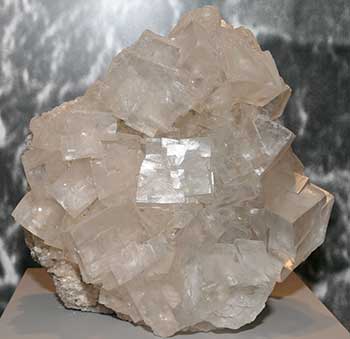 |
| Halite - NaCl. |
Salt (sodium chloride) is necessary to support life. As a mineral, salt is called halite. Salt is mined from rock salt deposits. When produced by evaporation from seawater, it is called sea salt. World resources of salt are practically unlimited. Worldwide, 225 million metric tons of salt is produced in more than 100 countries. The United States is the world's foremost producer (in 15 States) and consumer of salt. Salt in brine from solution mining is the major source of salt produced in the United States; "brine" is the term for water that is saltier than seawater. The chemical industry accounted for about 40% of salt produced (chlorine is a major product), and highway deicing for about 35%.
Background
Salt, composed of sodium chloride (NaCl), is one of the necessities of life for man and animals. Even in earliest times, man valued salt licks, springs, and marshes, and would go to great effort to visit them and carry salt away. In addition to the natural craving for salt which develops when it is absent from the diet, salt is valuable for preserving meats in hot climates.
Salt that is mined from solid layers in the ground is called rock salt. When produced along with other, usually powdery, salt-like compounds by evaporation from seawater, it is called sea salt or solar salt. Brine is the term for salty water from which salt can be produced. Geologically, salt is also known by its mineral name halite.
Pure halite is colorless, though it is often colored by impurities. It is soft and breaks (cleaves) into cubes. Halite crystallizes in the isometric (also called cubic) crystal system and when it forms crystals, it generally forms cubes. Its most noticeable and important physical feature is that halite is readily soluble in water. This allows halite to be useful in such varied applications as cooking, food preservation, and chemical production.
Name
The term salt is an ancient word, occurring in various forms in earliest English and in related languages. The formal mineral name for crystalline sodium chloride is halite, derived from the Greek word hals meaning salt. The mineral name was given by E.F. Glocker in 1847.In chemical usage, salt may refer to any compound of a metal and non-metal; thus terms such as "copper salts" or "magnesium salts" refer to the chlorides, carbonates, sulfates, etc., of copper or magnesium. "Epsom salts" refers to a specific hydrous magnesium sulfate mineral, made famous by its occurrence at a spring in southern England. Sodium chloride is sometimes referred to as "common salt" or "table salt", to distinguish it from other salts.
Sources
Salt can be mined from rock salt either by traditional mining practices using heavy equipment underground, or by pumping hot water in pipes into the salt deposit, where the hot water dissolves the halite. The resulting salt water is then pumped to surface and evaporated to yield salt. This is called"solution mining". In some modern dry salt lakes, a crust of halite can be recovered by simply scraping the salt crust off the lake bottom with bulldozers or scrapers. Ancient rock salt is mined in Michigan, New York, Kansas, and other states. Solution mining is used to recover salt from underground "salt domes" in Louisiana and Texas. Recovery of salt from dry lakes takes place in the deserts of California, Nevada, and Utah.
Much salt is produced by controlled evaporation of seawater or of brines in salt lakes. In this technique, the water is pumped or drained into shallow ponds. Solar evaporation will eventually (in an arid climate) concentrate the salt to the point where it crystallizes on the floor of the pond. This process is used around San Francisco Bay, at the Great Salt Lake in Utah, and elsewhere.
In the United States, rock salt accounts for one-third of the salt produced, while solution mining yields one-half the total. The remainder comes from evaporation of seawater and lake brines, and a small amount from salt crusts on dry lakes. The United States produces about one-fifth of the world's salt. However, the United States also imports about one-fifth of its needs from other countries, mostly from Canada and Chile.
Salt is produced in most of the countries on Earth. After the United States, the largest producers of salt are China, Germany, India, and Canada. In most other countries having a seacoast, salt for local use is produced by evaporation of seawater.
Uses
In every country, salt is used in food preparation. In some poor, non-industrialized countries, this is the principal use. However, in a heavily industrialized country such as the United States, the consumption pattern is quite different.
In the United States, over 40% of salt is used in the chemical industry (mainly for the production of chlorine and caustic soda), and another 40% as a de-icer on roads in winter. The remaining is consumed in several sectors, including manufacture of rubber and other goods, agriculture, and food processing including as table salt. Table salt accounts for only about 1% of U.S. salt.
Substitutes
Some other salts, such as calcium chloride and potassium chloride, can be used to de-ice roads and walkways. These options, however, are more expensive than salt. Due to the limitless, inexpensive quantities available, salt is not likely to be replaced in most of its industrial and domestic uses.